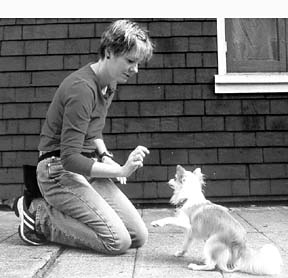-By Pat Miller
There are two kinds of dog people in this world: small dog people, and dog people who haven’t yet met and fallen in love with the right small dog.
I used to be a big dog person. I once owned a St. Bernard, and dreamed of owning an Irish Wolfhound. “Give me a big dog, a thumpin’ dog,” I used to say, referring to a dog who could withstand heavy patting. All my life, I looked disdainfully down on yappy little foo-foo dogs and the wimpy people who owned them.

Then, 13 years ago, a 10-month-old Pomeranian was surrendered by his owners to the shelter where I worked. I fell in love with – and adopted – Dusty. My whole perspective on the dog world shifted, as did some of my long-held paradigms on dog behavior, training, and management.
No longer did I scoff at people who snatched their tiny toys off the floor at the approach of a bigger dog. At a whopping eight pounds, Dusty had reached his full adult size, and I was constantly worried that I would step on him and break him, or that one of our bigger dogs might play with him too roughly and crush him. Or worse – some unknown dog with mayhem in mind could kill him instantly with one grab-and-shake move. Besides, it was just as easy – if not easier – to pick him up and carry him, so why not? The concept of “arm-dog” began to make perfect sense to me.
Big advantages
Once you adopt a small dog you realize that, safety concerns aside, there are some huge advantages to sharing your life with a mini-canine.
For example, they don’t take up as much room as your large dog – you can have several in the same space as one Great Dane. They share your bed without hogging it. They sit on your lap and still leave room for the newspaper. They don’t eat as much, so they are less expensive to feed, even with the best foods available. You can get by with smaller yards, and often, lower fences. They require comparatively less grooming. Little dog poops are tiny and inoffensive, even in the house – you can pick up their mini-feces with a tissue and flush them down the toilet. As a corollary, the small dog is much more realistic to litter-box train than a Mastiff, if that suits your fancy (see “Fine for Littering,” WDJ, September 2002).
You are much less likely to have to worry about counter-surfing with a little dog, nor is she as likely to knock over your 93-year-old Great Aunt Helen when she comes to visit (although a little dog can run under her feet and trip her up). The small dog is far more portable – you can fit her under an airline seat, in your shopping cart, or in a doggie backpack. Finally, she is less intimidating to people who are fearful of dogs, and more acceptable to landlords, hotels, motels, and other public places.
Of course, there are some disadvantages as well. Little dogs do break more easily, especially those with very fine bones, such as Chihuahuas and Papillons. Because of their small size, they can be mistakenly perceived as good pets for children. Some of them can be, but they are not automatically; it depends on the dog, good socialization, and the child’s ability to respect the dog’s small size. Their reputation as yappy and snappy is not entirely undeserved; they can become defensively aggressive if they feel threatened, and it’s easy to feel threatened when you are surrounded by human giants who are anywhere from 10 to 60 times your size. And because the dogs are small, owners tend to be permissive and overprotective, overlooking and excusing behaviors that larger dogs could never get away with. Which brings us to the topics of training and behavior management.
Small dog house manners
For optimum quality of life and relationship, it is every bit as important for the small dog to be trained as the large one.

Let’s arbitrarily define the “small dog” as one who is 25 pounds or less. This encompasses a wide range of breeds, from the tiny three-pound Chihuahua to the short and sturdy Scottish Terrier. It includes dogs with such varied personalities as the independent Jack Russell Terrier, amiable Pug, aloof Basenji, work-oriented Welsh Corgi, and the relatively phlegmatic French Bulldog, to name just a few. That doesn’t even take into consideration the infinite permutations of small mixed-breed dogs.
So forget any stereotype you may be holding of the “small dog” personality. The training challenges that small dog trainers face mirror to a large degree those faced by big dog trainers, and the same positive training methods work just as well.
There are some differences, however. The conventional wisdom that small dogs can be harder to housetrain is often a reality. There are several reasons why they are more likely to soil in the house, although it is not because they don’t have the instinct to keep their dens clean; they most certainly do. If your little dog’s housetraining is giving you headaches, it may be because:
• Small dog signals are harder to see. If a Rottweiler sits and stares at your face while you are reading the paper, you probably notice. If a Pomeranian sits and stares at your ankle, it’s easy to miss.
• Big dog owners may be more motivated. A tiny Yorkshire Terrier puddle behind the guest bed may not be discovered for weeks or months (or maybe never). The Great Dane lake in the kitchen is impossible to miss. It’s a simple matter to pick up a teeny Terrier turd, toss it in the toilet and dismiss the mistake. A moist, massive Mastiff mound is an entirely different matter.
• Small dogs have smaller holding capacities. Although you would expect their organ capacity to be proportionate to their size and intake, the bottom line is they do seem to need to go out on a more frequent potty schedule.
• Small dog owners are more likely to supervise less, use crates that are too large (in which the toy puppy can poop and pee in one end and sleep and play happily in the other) or not crate at all. A little pup can’t possibly be as much trouble as a big one, can she? (wrong!), and besides, we want Midge to sleep with us!
• Small dog owners are more likely to paper-train and continue to rely on paper-training, sending a mixed message about inside elimination versus outside elimination.
• Small dogs are more likely to have had their den-soiling inhibitions damaged by over-crating and dirty puppy mill conditions. If a dog is required to live in her own excrement and urine, she comes to think that living in filth is normal, and she won’t make an effort to “hold it” until she has access to a more suitable environment. This makes housetraining very difficult. Small dogs, by virtue of their size, are more popular as pet store and puppy mill breeds – both environments where they are more likely to be over-crated.
The answer to housetraining the small dog is scrupulous management. Constant supervision, through the appropriate use of leashes, crates, tethers, direct supervision, and regular trips to the outdoor bathroom spot – every hour on the hour, at first, if necessary (see “Tethered to Success,” WDJ April 2001). Pay close attention so you don’t miss your dog’s signals. All of the other regular housetraining tips also apply, of course: Feed regular meals instead of free-choice feeding; pick up water before bedtime, change crate substrate if necessary, and clean soiled spots with enzyme-based animal product cleaners.
The small dog owner often overlooks other house manners as well. Jumping up is much easier to accept when the dog is 5 pounds than 50, so lots of small dog owners don’t bother to teach a polite greeting. Our four dogs range in size from 8 pounds to 80, and all of them know to greet people without jumping up. They also wait for permission before getting up on the sofa.
This can be accomplished with a small dog just as it is with a big dog, by preventing her from being rewarded by the behavior you don’t want, and consistently and generously rewarding the behavior you do want with treats, toys, or a nap on the sofa.
This means turning your back on the jumper and petting her (and/or giving a treat) when she sits. She will soon learn to sit to get your attention. Be sure you give it! It also means body-blocking your dog when you see the “sofa gleam” in her eye – by moving into the open sofa space and/or not making your lap available – until she sits, and then inviting her up (assuming she is allowed up). Be sure to notice when she sits, and invite her up when she does; as small as she is, she is easy to overlook when she is sitting politely. These two behaviors are actually much easier to accomplish with your small dog than a large one.
Your small dog also needs to be well socialized. Treat her like a dog! Lots of positive experiences from early puppyhood will help dispel the aggressive “arm-dog” image of the angry Pomeranian nestled in the ample and befurred bosom of the wealthy dowager. Your little dog needs to have her feet on the ground a good part of the time so she can learn to go up and down stairs, get into cars, and walk on grass, dirt, gravel, carpeting, wood and tile floors.
Take her hiking. (In his younger days, Dusty could easily hold his own on an all day wilderness hike with the rest of our pack.) Have her meet lots of friendly people – all ages, shapes, sizes and races – armed with lots of tasty treats in lots of controlled circumstances. A good rule of thumb for socialization is to expose your pup to at least 90 different settings and types of people before she is four months old.
Basic small dog training
It is true that there are lots of little dogs who strain on their leashes, don’t come when called, and who think “sit” is something their owners do so the human can bend over and pet the dog. Yet the small dog is every bit as capable of learning basic and advanced training behaviors as the big dog – and it is just as important for their long term well-being and safety.
If you doubt a little dog’s ability to learn, just watch any canine competition. You will be amazed by the number of diminutive canines who compete successfully in Obedience, Agility, Rally, Flyball, and more.
Positive training techniques are the same for all sized dogs – they all have canine brains that respond similarly to the four principles of operant conditioning. There are some considerations for small dog owners that can make the relationship-building/training process more successful. Whether your goal is a well-mannered house dog or competition titles, if you keep the following concepts and tips in mind you and your small dog can both have more fun playing the training game together.
1. You are very big.
Primate body language (direct approach, looming over, eye contact, assertive gestures and voice) is intimidating to any dog who has not learned to read and interpret “human.” In the dog world, these behaviors are considered rude and offensive. The smaller the dog, the more threatening our natural human body language can be. When you are training your small dog, at least at first until she learns to read and trust you, be very conscious of using soft eye contact, making your gestures and voice small and soft rather than large and effusive, turning slightly sideways to her, and squatting instead of looming over your dog to interact with her.
2. Your dog’s stomach is very small.
I already remind dog owners to use small pieces of food treats and perhaps cut back on the size of their dogs’ regular meals, to prevent filling up before training is over and to avoid unwanted weight gain. Small dog treats must be very tiny; you may even need to eliminate some of their meals.
3. Work on the floor.
If you always train your little dog when you are standing up, you are guaranteed to end up with a sore back. Exercises like “puppy pushups” and luring the down can be especially backbreaking from full height. In the beginning, especially when teaching stationary exercises, sitting on the floor with your dog will save your back, and at the same time make you less intimidating to her. You can also work with your small dog while you sit in a chair, or you can put her on a raised surface where she is comfortable, such as a table, sofa, or bed.
4. Stand up and use a target stick.
You also need to train your dog while you are standing up – at least some of the time. She should learn to walk politely with you; even a small dog can damage her throat if she constantly strains at the leash. The better her leash manners, the more fun it will be to take her places, and the less likely she will become an arm-dog. You can teach her to target and then use your target stick to help her learn to walk with you, without having to bend over. Simply put the target stick where you want her to be. (See “On Target,” WDJ March 2001.) You can also attach a soft treat to the stick for delivery to the little dog without having to bend over, or just drop treats on the floor.
5. Use appropriate-sized training tools.
Little dogs need lightweight collars and leashes. It’s easy to underestimate the impact of a standard-weight leather leash if it accidentally bumps into your dog’s face, or, worse, if you drop your end and it falls on her. Her training tools and toys should be scaled appropriately to her size – pet suppliers have gotten wonderfully creative with small dog products like toy-dog-sized tennis balls and narrow, lightweight nylon leashes. Flyball boxes even have a spot that can pop out a mini-tennis ball for toy-sized team members.
Play it safe and smart
One of the reasons little dogs sometimes get an attitude about big dogs is that owners tend to panic when they see a big dog approaching. The owner’s stress transmits to the small dog, who then becomes anxious herself. If you grab your dog every time another dog approaches, it will increase her stress and the potential for a confrontation.
Little dogs sometimes do get savaged by big dogs because their owners forget to think. “Be smart” means don’t take your little dog places that you know are frequented by large, uncontrolled dogs. Only use your local dog park if there is a separate fenced area for small dogs.
If you are walking your dog on the street and you see someone approaching with a large dog, take evasive action – calmly cross the street while you practice good heeling so you can pass at a safe distance. If you see a loose dog approaching, look for an escape route – a place of business or fenced yard you can step into for safety. Carry an aversive spray such as “Direct Stop” that can thwart a persistent canine visitor. (See “Break It Up,” WDJ December 2002.) Only as a last resort should you pick your dog up – doing so also puts you at risk for injury if the approaching dog is intent on attacking.
Not that the risk of injury would stop any of us “small dog people” from protecting our beloved little ones. Like any dog owner worth her salt, our own safety is the last thing we think about when our canine family members are threatened. Their diminutive size only heightens the protective instinct that would cause us to risk life and limb for them.
Go ahead, big dog people, scoff at us if you want. It’s only a matter of time before you meet the small dog who steals your heart.
Pat Miller, WDJ’s Training Editor, is also a freelance author and Certified Pet Dog Trainer in Chattanooga, Tennessee. She is the president of the Board of Directors of the Association of Pet Dog Trainers, and published her first book, The Power of Positive Dog Training, in 2002.






